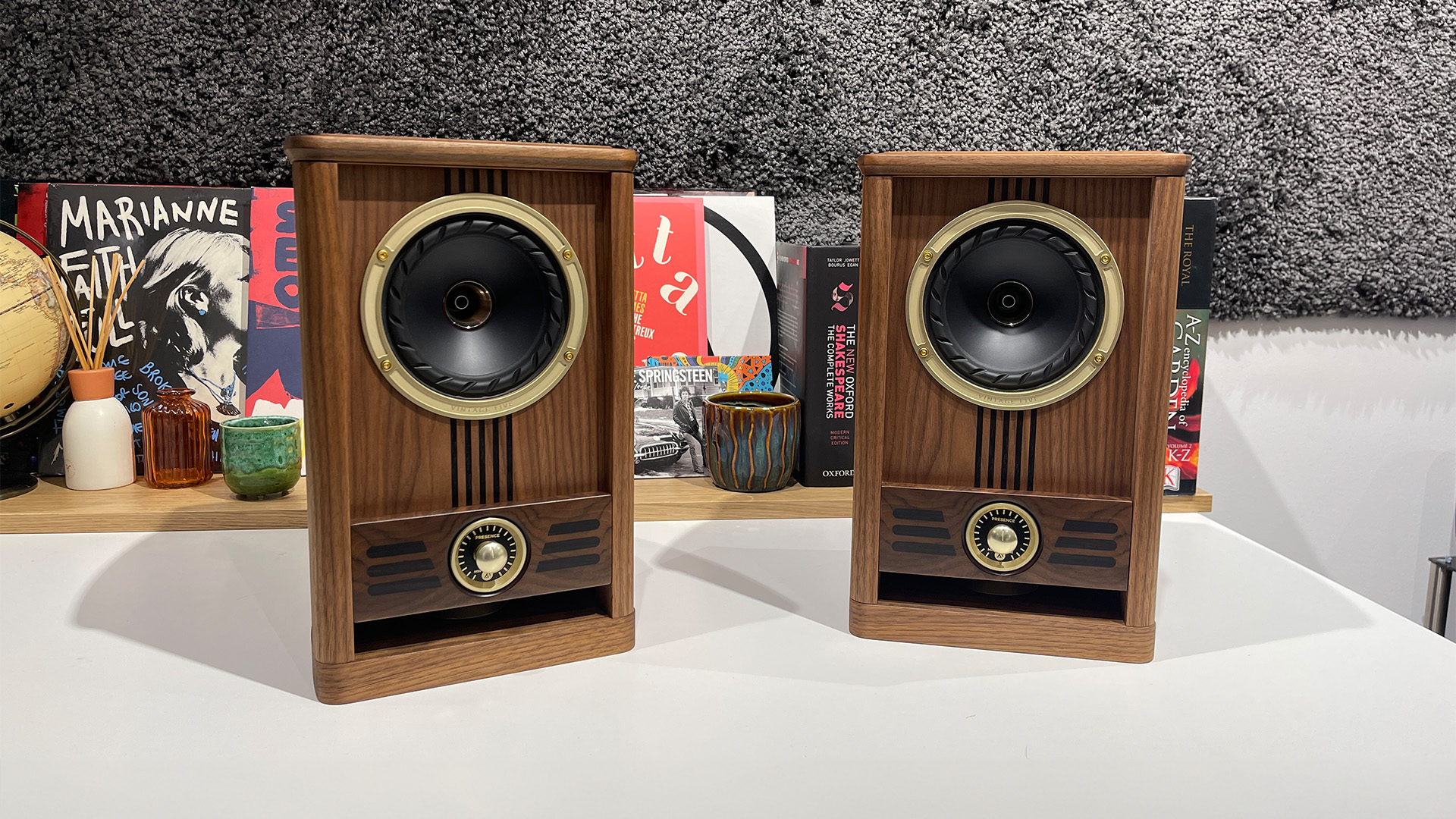What Hi-Fi? Verdict
Fyne’s Vintage Five is a charming and capable performer that excels in smaller rooms
Pros
- +
Clarity and dynamic presentation
- +
Impressive resolution
- +
Precise stereo imaging
- +
Lovely build and finish
Cons
- -
Work best in smaller spaces
- -
Need to be partnered with care
Why you can trust What Hi-Fi?
We have something of a soft spot for Fyne Audio’s Vintage speaker range. It mixes old-world aesthetics with thoroughly modern engineering in a way that we find hugely appealing. Currently, it is a four-strong series that starts with the diminutive Five we have on test here and ends at the wardrobe-sized Vintage Fifteen that packs a whopping 38cm (15in) mid/bass driver and costs around ten times as much.
While the three bigger models, all floorstanders, can fill some pretty large rooms with sound, the Fyne Vintage Five standmount speakers are more suited to cosier spaces. That’s easy to understand given that they stand just 35cm tall and sport a relatively small 12.5cm mid/bass driver. This being a Fyne Audio product, it is no surprise that a tweeter sits at the centre of the mid/bass unit in an arrangement the company calls Isoflare. The idea is that the acoustic centres of each driver (the place where it appears to generate sound) are on the same axis and better time-aligned. The benefits over conventional separate driver placements range from more even dispersion characteristics to better integration between the two units.
Design & engineering
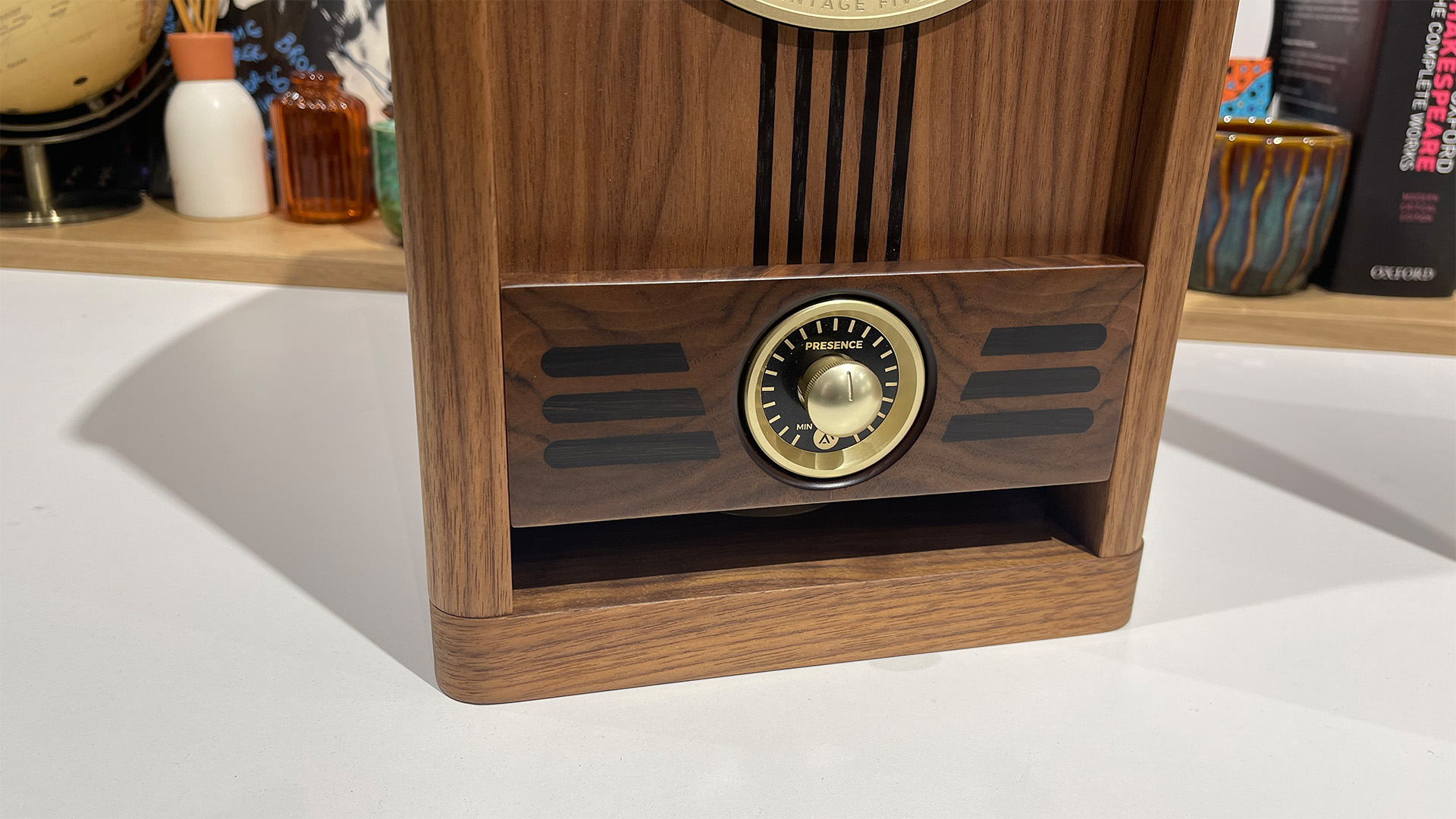
That tweeter is a 19mm magnesium dome compression unit driven by a vented neodymium motor system and is linked to the multi-fibre paper mid/bass unit through a high-quality 2nd order crossover. This filter network is cryogenically treated to relieve internal stresses in the components and crosses over at 1.9kHz. The speaker’s internal wiring is silver-plated copper from Van Den Hul.
Look around the mid/bass unit’s cone and you will find an indented rubber surround. The surround is this shape to improve its ability to damp cone resonances. The result should be a cleaner, less distorted sound. The Vintage Five’s bass is tuned by a downward-facing reflex port that fires onto a cone-shaped diffuser. Fyne Audio call this arrangement Basstrax and it is designed to disperse low-frequency sounds more uniformly. The advantage of such an approach is that it makes the speakers less fussy about their position relative to the room walls. You can see the diffuser through the slot low down on the speaker’s front baffle.
Above this slot, you will find the ‘Presence’ dial. This tone control only affects the 2.5-5.0 kHz region and is relatively subtle in operation giving a maximum adjustment of plus or minus 3dB. That frequency band influences how we perceive vocal clarity and stereo image depth. In our reference set-up, we favour leaving the Presence control in its central position, as that is where the speaker sounds most balanced to us. It would be nice to have an indent to mark this point, but other than that we have nothing but praise for the control’s smooth, well-damped action.
Build & compatibility
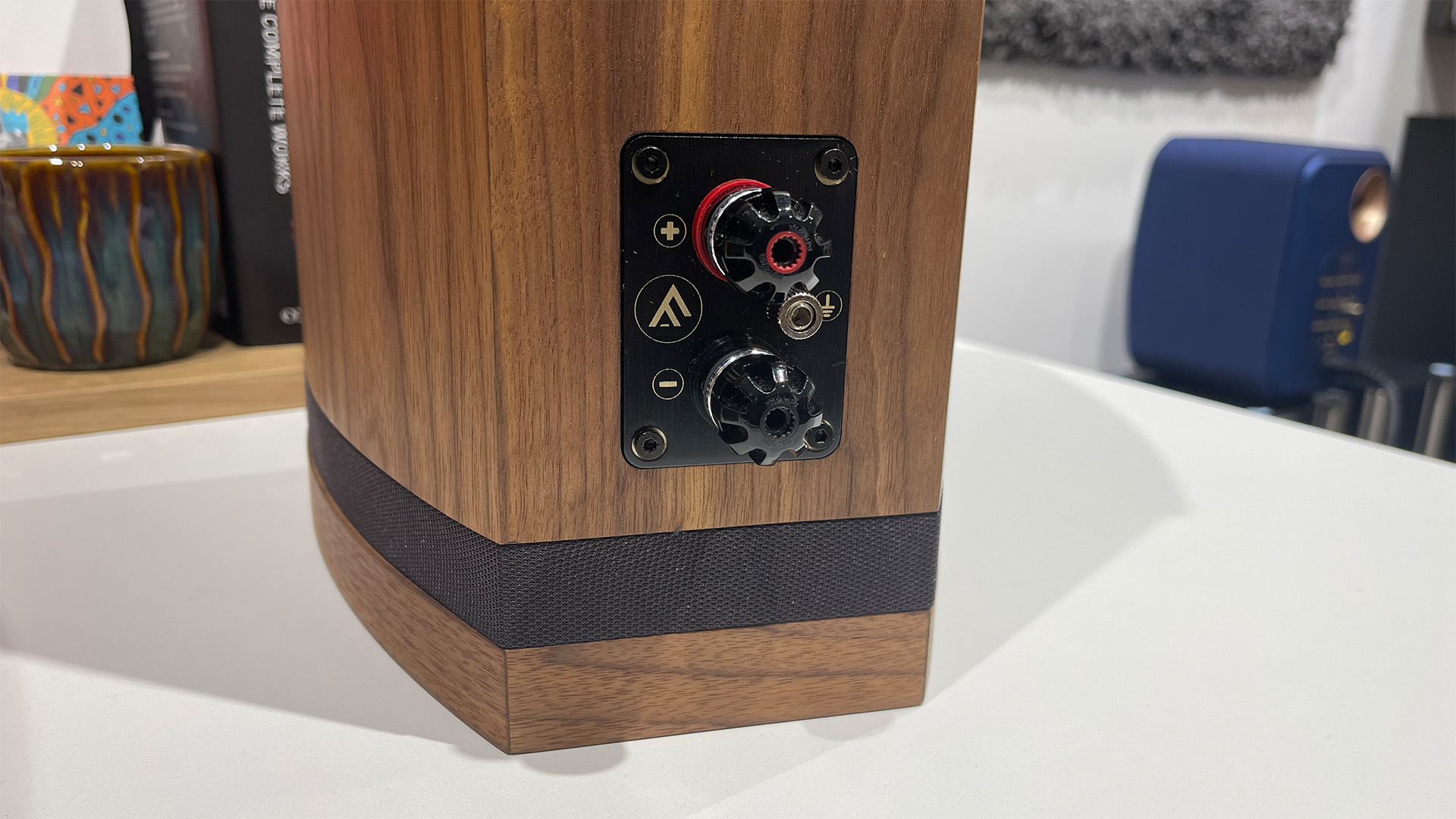
While the Vintage Five’s old-world appearance splits opinion in our office there is no denying the high standard of build and finish; these speakers feel like pieces of expensive furniture rather than hi-fi components. The speaker’s enclosure is made of high-density birch ply and internally damped by a combination of bonded acoustic fibre and polyether foam. Its walnut veneer is hand finished and those lovely dark inlays on the front baffle are burr walnut. It all adds up to an impressively luxurious tactile experience.
Look around the back of the cabinet and you will find a single pair of WBT Nextgen binding posts and a terminal for grounding. It is well worth connecting this grounding terminal to your amplifier, as it results in a small but definite improvement in clarity and refinement.
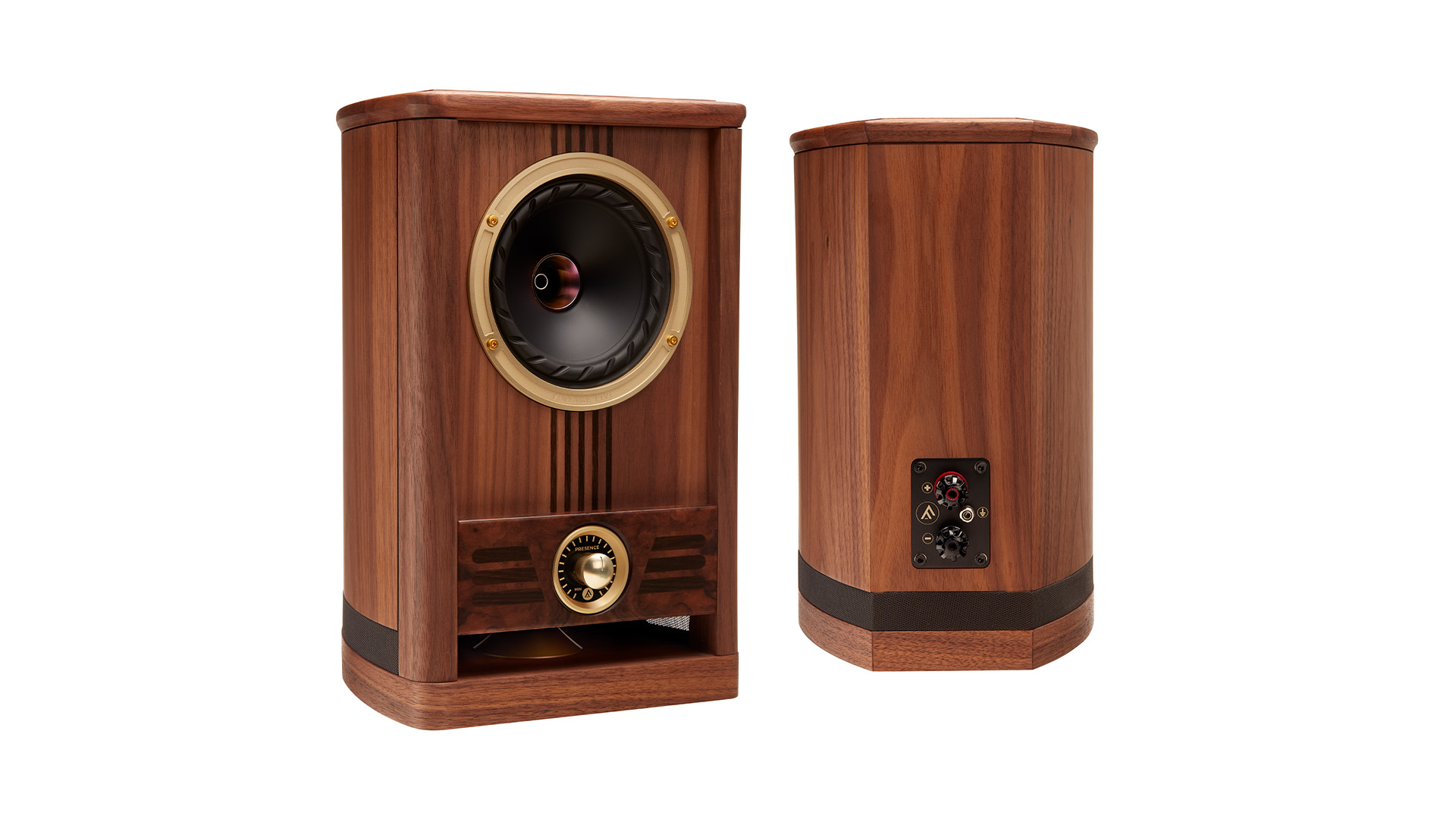
Type Standmount
Drive units 19mm magnesium dome tweeter, 12.5cm multi-fibre paper mid/bass
Ported? Yes (downward)
Bi-wire? No
Impedance 8 ohms
Sensitivity 87dB
Dimensions (hwd) 35 x 22 x 26cm
Weight 6.2kg
Finishes x 1 (Walnut)
These speakers have a claimed sensitivity of 87dB/W/m and a nominal impedance of 8 ohms, so they shouldn’t be too demanding to drive when used in smaller rooms. Relatively low-powered valve amplifiers with outputs ranging from 20 watts per channel upwards are likely to get decent volume levels. We have no issue with loudness when using transistor-based integrated designs such as Arcam’s A5 (50 watts per channel), Naim’s Nait XS3 (70 watts per channel) or PMC’s Cor (95 watts per channel) in our large 3 x 7 x 5m hwd test room. Our Burmester 088/911 MkIII reference amplifier (180 watts per channel) predictably drives the Vintage Five without issue, though these speakers can’t make the most of such an amplifier’s muscularity. Their strengths lie elsewhere.
These are revealing speakers so it makes sense to feed them with a high-quality signal. Our main sources are Naim’s ND555/555 PS DR music streamer, the Technics SL-1000R/Kiseki Purpleheart MC record player and a Macbook Pro loaded with Audirvana music-playing software and connected to a Chord Hugo TT DAC.
All standmounts are reliant on the quality of their support. While the small size of the Vintage Five might encourage you to put them on a bookshelf or a wall bracket, they sound best when given a nice solid speaker stand to sit on. Fyne makes suitable supports, but there are many good alternatives from the likes of Atacama, Solid Steel and others that will suit. Your dealer should be able to advise on what will work best in your room.
These are small speakers so it is no surprise that they work best in small to medium-sized rooms. We have heard them sound remarkably capable in larger spaces, but the inevitable limitations in terms of low-frequency reach and authority are obvious. While they will tolerate being put right up against a wall, we find that their bass turns a little lumpy and stereo image depth flattens when used this way. It is much better to give them a little space to breathe. The handbook suggests 50cm from the rear wall, which seems right to us.
After experimenting with placement, we ended up with the speakers slightly angled towards the main listening position, pointing so they cross around a metre or so beyond our heads. Positioned in this way, the stereo imaging clicks into place. The benefits of the Isoflare arrangement mean that the soundstaging stays stable across a broader spread of listening positions than a conventional driver arrangement would typically manage.
Sound
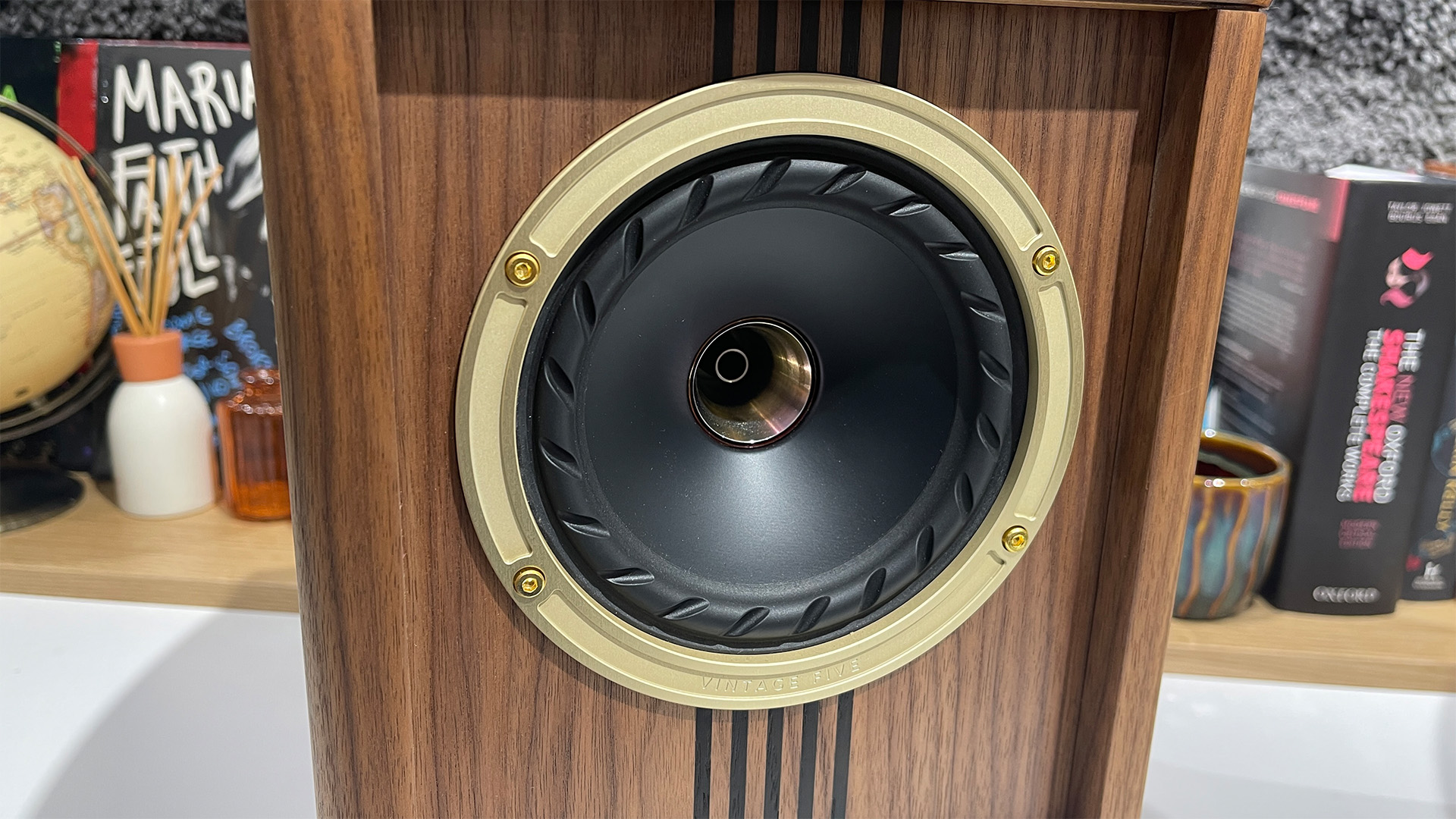
The Fyne Vintage Five turns in a charming performance once everything is optimised. They are never going to deliver seismic bass or be able to play at very high volume levels without sounding strained. This applies to a lesser or greater extent to every small speaker, so it is something that just has to be accepted. Given that, it is also fair to say that this little gem does better in these areas than we expected.
As we listen to Rag ‘N’ Bone Man’s Human it is genuinely impressive just how much low-end heft the Five delivers for something so small. The lows are surprisingly taut and tuneful, which speaks highly of the mid/bass unit and the effectiveness of that sophisticated Basstrax arrangement. These speakers sound cohesive and musical. The song’s simple but persistent rhythm comes through with momentum and there is plenty of attack when required. Detail levels are high and these boxes have no trouble organising all that information into something that holds our attention over longer listening sessions.
As we switch from Górecki’s Symphony No.3 to Nina Simone’s Feeling Good and 070 Shake’s You Can’t Kill Me set it becomes increasingly clear that these are impressively transparent speakers. The differences between the various productions and recording technologies become obvious very quickly. It comes down to excellent resolution, low distortion and the ability to cope with both micro and macro dynamics convincingly.
The Górecki piece shows off the Fynes’ terrific stereo imaging; their ability to float a broad soundstage and fill it with precisely located instruments is excellent. The speaker’s innate composure means the imaging stays stable even when the music becomes demanding. Detail? We can tick that box too, with these standmounts able to resolve low-level acoustic subtleties that help to identify the size and scale of the recording venue easily. That kind of talent isn’t usual at this level.
Tonally, these are reasonably balanced but the higher frequencies could be a little sweeter and more refined. Careful partnering with well-behaved electronics is a must. Get it right and you will find that the bite and clarity of the top-end overshadow any lack of top-end sophistication.
The Nina Simone track allows the Vintage Five to show off their lively nature. The song bursts with energy and Simone comes through with unrestrained passion and drive. Some rivals may be more refined than these Fynes, but few deliver sound with such verve and articulation.
Verdict
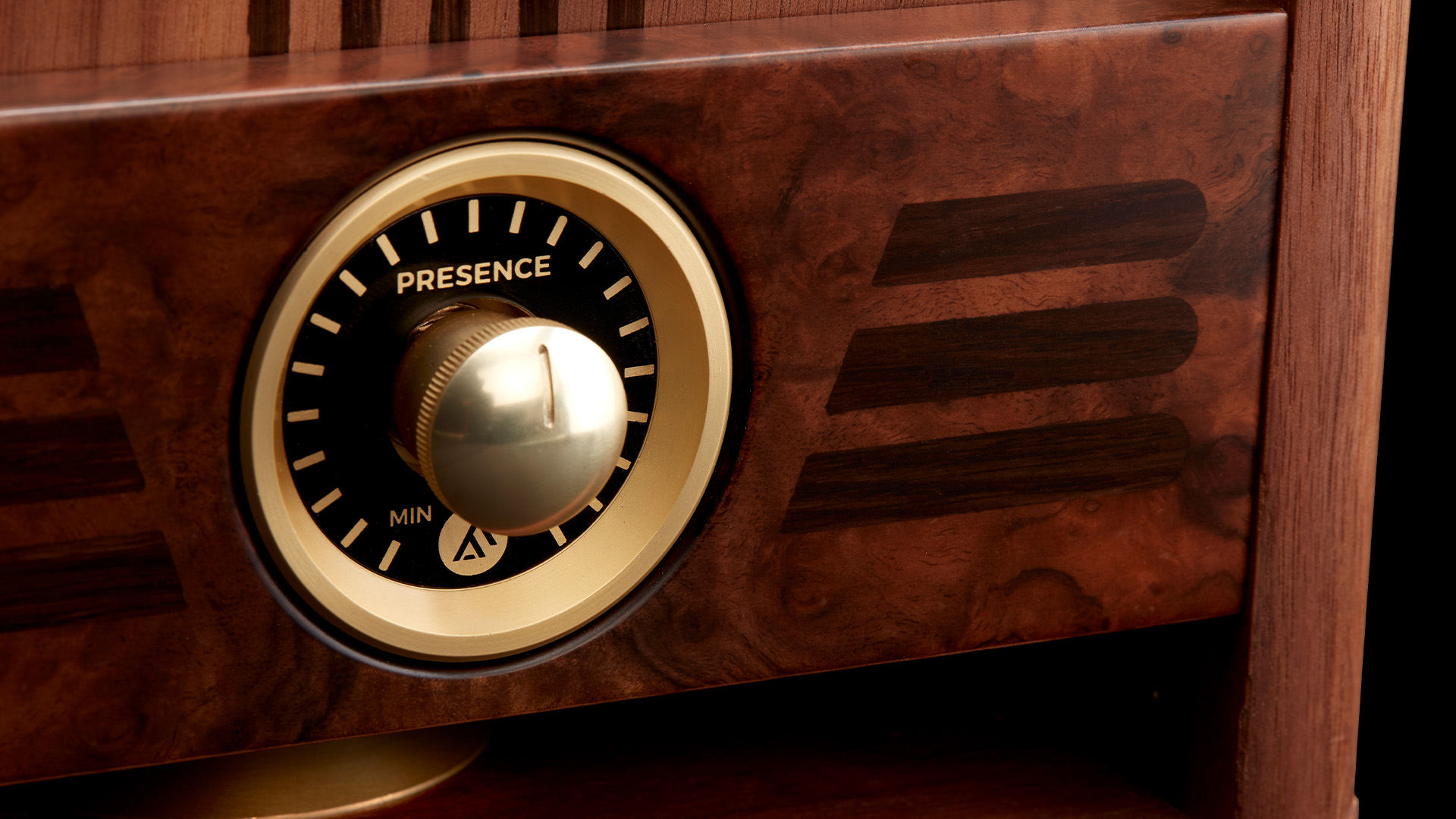
The Vintage Five are easy speakers to underestimate. The retro appearance suggests that they are for those who yearn for the past, and their dinky size makes them harder to take seriously, especially at what looks to be a high price. But consider the exceptional build, quality of engineering and, when used in an appropriate system, terrific sound, and it is hard not to be won over. We certainly are.
SCORES
- Sound 5
- Build 5
- Compatibility 4
MORE:
Read our review of the ProAc Response D2R
Also consider the Neat Petite Classic
Read our Fyne Audio F1-8 review
Best bookshelf speakers: top standmounts for every budget tested
What Hi-Fi?, founded in 1976, is the world's leading independent guide to buying and owning hi-fi and home entertainment products. Our comprehensive tests help you buy the very best for your money, with our advice sections giving you step-by-step information on how to get even more from your music and movies. Everything is tested by our dedicated team of in-house reviewers in our custom-built test rooms in London, Reading and Bath. Our coveted five-star rating and Awards are recognised all over the world as the ultimate seal of approval, so you can buy with absolute confidence.
